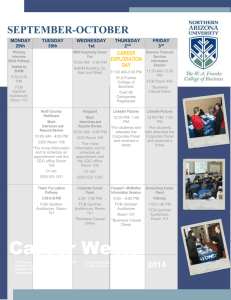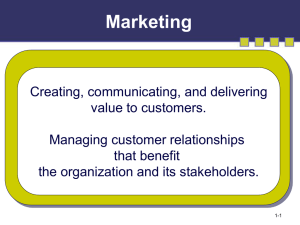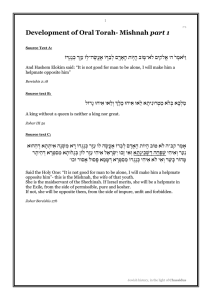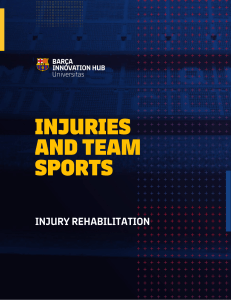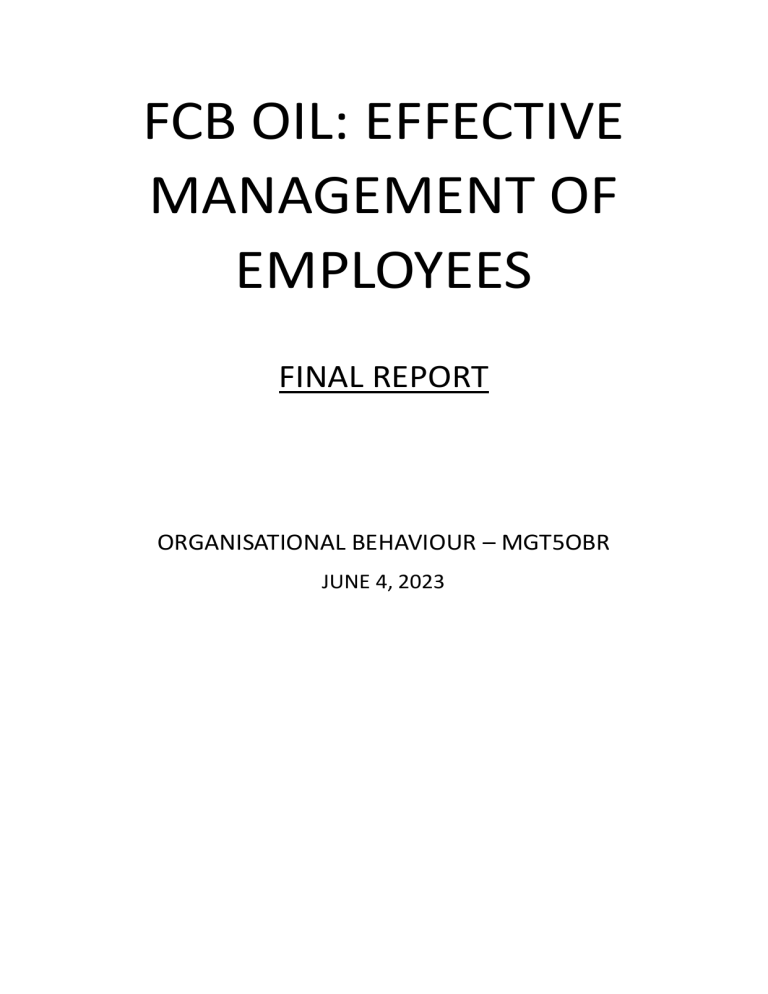
FCB OIL: EFFECTIVE MANAGEMENT OF EMPLOYEES FINAL REPORT ORGANISATIONAL BEHAVIOUR – MGT5OBR JUNE 4, 2023 Table of Contents INTRODUCTION ...................................................................................................................................... 3 WHO ARE FCB OIL? ................................................................................................................................. 3 OVERVIEW .............................................................................................................................................. 4 ISSUE ANALYSIS & RECOMMENDATION................................................................................................. 4 TEAM INEFFECTIVENESS & TEAM EFFECTIVENESS MODEL ............................................................... 4 CONFLICT & CONFLICT RESOLUTION ................................................................................................. 8 JOB DISSATISFACTION & MCCLELLAND’S LEARNED NEEDS THEORY............................................... 11 LACK OF MOTIVATION & MASLOW’S HEIRARCHY OF NEEDS THEORY ........................................... 13 CONCLUSION ........................................................................................................................................ 16 REFERENCES .......................................................................................................................................... 18 INTRODUCTION The purpose of this report is to take a deep delve into FCB Oil, its current employees and management of said employees. This report also aims to deduce problems facing the company internally and proffer solutions using Organisational Behaviour learning and techniques. At the end of this report, FCB Oil would have a template of what is currently lacking within their organisation as regards their employees. Furthermore, they will also be provided with thoughtful insight and recommendations on how they can tackle those problems, improve their employee wellbeing and trend towards the right direction. Ultimately, the goal is to use these learnings and suggestions towards improvement to achieve or at least approach organisational effectiveness for FCB Oil. WHO ARE FCB OIL? FCB Oil is an Australian company with a portfolio that includes oil, gas, petroleum, and everything in between. FCB Oil is listed on the Australian Securities Exchange (ASX). ASX has been in existence for over a century and currently has over 35000 employees across its businesses here in Australia and subsidiaries all over the world. Like many or perhaps even all organisations, FCB Oil has a culture that spreads across headquarters and subsidiaries worldwide. This is why for the most in-depth understanding of the culture and ‘feel’ for what FCB Oil is about, this report is based on their headquarters here in Australia. Just like human anatomy, if the head goes one way, the body cannot go another way. Likewise, FCB Oil and its subsidiaries. If there is a clear direction the headquarters and core of the company has chosen to go, the rest of the organisation will follow, effectively having a set of shared norms and values flowing throughout the organisation. However, we must first understand FCB Oil. OVERVIEW After observing, researching, and asking the right questions to the right people including leadership, management and perhaps most importantly, the staff, we have been able to amass great knowledge about the issues plaguing FCB Oil at all levels. Additionally, we have made suggestions, recommendations and discovered potential solutions to those issues. We have discovered that at both organisational and group levels, there is a lack of team effectiveness that often hinders team survival. This report provides a team-effectiveness model that will solve this problem if followed. Additionally, at group and individual levels there are also issues like conflict, lack of motivation and job dissatisfaction. In the same order they were listed, these issues can be solved by Organisational behaviour concepts, models, and theories like conflict resolution management, Maslow’s hierarchy of needs theory and McClelland’s learned needs theory respectively. This report sheds light on how these problems plague FCB Oil and how the recommended theories go a long way towards solving them. ISSUE ANALYSIS & RECOMMENDATION TEAM INEFFECTIVENESS & TEAM EFFECTIVENESS MODEL While carrying out research into FCB Oil, it quickly became apparent that there was a severe lack of team effectiveness in group tasks, and this can only have negative implications for the organisation. There was an overwhelming number of employees who were fed up with members of the group who received compensation despite their contribution in the group drastically reducing over time. Something Guido, Robbett and Romaniuc (2019) described as free-riders. People who stop cooperating in the group after noticing that other group members will get the job done and at the end of the day, everyone gets rewarded (Comer, 1995). Team members in FCB Oil have described this as a reason for dwindling team effectiveness and is corroborated by Guido, Robbett and Romaniuc (2019); . Additionally, conflict was also listed by employees as a reason why team effectiveness within their teams and organisation was on the decline. One member said, “having to go through the process of picking one idea that everyone agrees with is draining, the endless meetings, and once it’s done, I do not even have the bandwidth to take on the actual task”. This matches what O’Neill and McLarnon (2018) discovered about conflict being inevitable in group tasks because of the interdependencies group members have of one another in order to achieve their goals and ultimately, team effectiveness. Furthermore, another issue that is prevalent among team members in FCB Oil is low engagement of group members. This is a concern of more than a fair few team members as some even claimed it was their biggest regret about working in groups. For example, someone explained that when things kick off in the group, things are well, and people try to get to know each other. Then ideas are shared and agreed upon by team members. These are two normal stages of working together. However, members whose ideas are chosen suddenly take charge of the spotlight, while those whose ideas were not chosen will be thankful to even get a role as they quickly fade to the background, completely ignored. This lack of engagement is consistent with O’Neill and Salas (2018) who stated that low engagement is counter-effective to creating high performance teams within organisations. O’Neill and Salas (2018), also named knowledge-boundary as a big reason why teams are ineffective. The inability of team members to keep up with the tasks, simply because their knowledge is too limited. This problem also exists within FCB Oil as members claim that team goals are not achieved because too much of the same or similar individuals are within one group. Similarity in perception, personality or even departments within the organisation. When similar individuals are put together, it limits the scope of ideas that could come from the group, which will now have an adverse effect on goal accomplishment. Another barrier to team effectiveness within FCB Oil as named by the employees is gender imbalance. Park, Grosser and Roebuck (2020) describes this as being in the minority. When this happens, the likelihood that the member can create friendship ties and bonds are slim. The factors negatively influencing team effectiveness at FCB Oil are long and seemingly unending. However, using the right organisational behaviour concepts or techniques, the situation can be reversed, and team effectiveness can be achieved. The best way forward for FCB Oil is to implement a mix of models and theories starting with the team effectiveness model. This model focuses on how teams can turn inputs into outputs via internal processes (Wagner & Hollenbeck, 2014). It is also important to acknowledge that this is based within the open systems perspective and that the individuality of teams are based within much larger circumstances like the organisation and team environment (O’Neill & Salas, 2018). Organisation & Team Environment: According to Wagner and Hollenbeck (2014), the foundations for team effectiveness can be laid if the organisation and team environment have the following: Organisational structure that supports autonomy, interaction, and natural interdependencies. Organisational culture and leadership that is supportive of teamwork and collaboration. Reward Structure: This particularly tackles the issue of free riders in FCB Oil. The management needs to ensure it considers individual performance within group dynamics before rewards are given. This means that free riders will have to pull their weight if they want acknowledgement or rewards. Moving forward, FCB Oil’s reward structure must be a mix of team and individual just to balance things out. Boundary Spanning: The idea of connections and relationships outside of the team dynamics. This also helps boost team synergy. Inputs: These are the formation and outlook of the group that includes composition, and sizing group according to task. An effective group should be made up of individuals with diverse backgrounds, different personalities and cultural orientations (O’Neill & McLarnon, 2018; Park et al., 2020; Wagner & Hollenbeck, 2014). This automatically widens the scope of knowledge within the group, thereby solving FCB Oil’s problem of knowledge-boundary within groups. Internal Process: These are components that must be present within a group for them to be able to achieve the desired outputs and effectiveness. They include team development, norms and roles, communication (Wagner & Hollenbeck, 2014). For groups to develop to their fullest potential at FCB Oil, we recommend Tucker’s Model of Group Development. This model emphasises the inception, growth and fulfilment of a group and its members. The 5 stages in this model include: Forming: Group members are independent in this stage and going through orientation. This is the foundation (Anderson, 1993) Storming: This is where ideas are shared and conflict also comes in. However, the benefit of this conflict is that group members are only trying to achieve the best possible results in their task (Anderson, 1993). If FCB Oil uses this model to form their groups, conflict will only be an issue in this stage and eventually harshed out. Norming: The group’s development is now in the dependece/interdependence phase. Here, the members of the group are now held to a standard which cannot be achieved unless they lean on one another (Anderson, 1993). Performing: Still in the interdependence phase, group members are now working on tasks together and achieving set goals (Akrivou et al., 2006). Adjourning: This is the last stage of the group but is a sign of an ineffective group because it means they are going back to independence and could not survive ((Anderson, 1993) Step 4 of the Tuckman model also represents the ideal output of an effective team which is accomplishment of tasks. At FCB Oil, the manager must combine the team effectiveness model, the Tuckman development model with an environment that includes rewards, leadership, communication, culture etc. When all this is in place, in no time at all FCB Oil’s teams will be known for one thing: effectiveness. CONFLICT & CONFLICT RESOLUTION As mentioned earlier, conflict is a problem at the meso-level in FCB Oil. Unfortunately, it is also a problem that runs much deeper and reaches bothe micro and maro levels. Conflict within an organisation is inevitable due to varying profiles, perceptions and beliefs of members (Pondy, 1992). No surprise that it exists at FCB Oil. It is normal. On the other hand, conflict can either be good or bad. The positive being that it is functional, serves as a tool for learning and ushering in change (Pondy, 1992; Wagner & Hollenbeck, 2014). Alternatively conflict could be dysfunctional, lead to turnover and decimate performance levels (Pondy, 1992). Within FCB Oil, employees have complained about how conflict ruins the mood, leads to tardiness and affects output. This points to one thing, dysfunctional conflict. When further probed about the origin of conflict within the organisation, the staff mentioned that more often than not, conflict brews over time. Similar to Wagner and Hollenbeck (2014), who noted that conflict develops gradually and ultimately is not a surprise when it becomes public. In order for FCB Oil to reach its full effectiveness and eliminate threat to thst goal, it must first understand the types of conflict and how to stifle it. According to Jehn (1997), task, relationship and process are the three main types. FCB Oil will benefit the most from alleviating relationship conflict because unlike the other two, satisfaction and task performance are only negatively affected (Jehn, 1997). Relationship conflicts divert focus from tasks and move it to interpersonal and emotional aspects. If this continues to be prevalent, FCB Oil and its managers will be unable to achieve effectiveness. For managers at FCB Oil to effectively navigate conflict and increase effectiveness, they should adopt the the dual concern model. This model is appropriate because it appreciates the varying nature of conflict within an organisation and enables managers with the flexibility to handle different scenarios. This model also brings into focus the level of a manager’s concern for self and for others – again, depending on the situation (Rahim, 2002). Using this model, the following are the approaches managers at FCB Oil can use to negotiate the tricky waters of conflict. Integrating Style (high concern for self and others): This is valuable especially during task conflicts (Rahim, 2002). Managers at FCB Oil can solve conflicts by taking ideas from both individuals in order to reach a conclusion. This ensures that both parties are satisfied and conflict is averted. Obliging Style (low concern for self, high concern for other): This style is characterised by managers or a party in conflict downplaying dissimilarity and highlighting commonalities (Rahim, 2002). Dominating Style (high concern for self, low concern for others): At FCB Oil, managers can use this when a decision needs to be made immediately. This means that the opinions of those in conflict might be discarded and sometimes, when neither party wins, conflict is also avoided (Rahim, 2002). Avoiding Style (Low concern for self & others): This involves abstaining from participating actively in conflict processes or being impartial at all costs (Wagner & Hollenbeck, 2014). Managers at FCB Oil can avoid adding input to conflicts that have the potential to become dysfunctional (Rahim, 2002) Compromising Style (intermediate concern for self & others): Managers can use this style when involved in negotiations and have to come to a level ground with the other party to reach a mutually beneficial agreement (Rahim, 2002). It is also a useful style for dealing with parties that can cause significant disruption and dysfunction, when for example a dominating style is used (Wagner & Hollenbeck, 2014) Overall, FCB Oil is not experiencing a unique problem in conflict. However, it is a problem that cannot be allowed to fester. Using the proposed dual conncern model, managers at FCB Oil now have a way to deal with a wide range of conflict types within the organisation. JOB DISSATISFACTION & MCCLELLAND’S LEARNED NEEDS THEORY Job dissatisfaction also stands out as a major issue within FCB Oil and while it’s not an uncommon problem, it could cause a lot of damage if not addressed. This could be because of several personal and professional reasons like poor management, lack of advancement, work-life balance, underpay, and unsupportive managers (Arian et al., 2018). Sometimes the lack of career growth and development could also cause job dissatisfaction. Within FCB Oil, the first sign of job dissatisfaction was a lack of interest in the workplace. Employees would be getting engaged in some other activities such as texting and chatting with their friends. This shows their disinterest and the organisation’s productivity is greatly impacted. Job dissatisfaction would reduce the performance and morale of workers (Jaradat, 2020). It could negatively impact the bottom line of the employees as well. When employees don’t get engaged in the work, their motivation decreases, so does the quality of service and in extreme cases high turnover (Osemeke & Adegboyega 2017). Among the staff at FCB Oil, a few of the glaring key indicators of job dissatisfaction are lack of enthusiasm and interest. This tallies with Kumbali (2014) who stated that dissatisfied employees show disinterest in their work and put less effort into finishing tasks. Using McClelland’s 3 needs theory, FCB Oil can combat job dissatisfaction amongst employees. This theory states that every individual contains many driving motivators which are a need for affiliation, achievement, and power. The mentioned motivators tend to be not essential and it is required to get it developed through life and cultural experiences. This theory has been proposed by David McClelland, a psychologist. Leaders could motivate employees by gaining a good understanding of individual requirements and determining the ways for satisfying their needs (Arnolds & Boshoff, 2003; Royle & Hall, 2012). This theory will help FCB Oil do the following; Determining Drivers: that is determining the types of drives used for motivating the employees. Establishment of motivators. After learning the primary driver of employees, effective ways could be used for motivating them. Implementing the process Refining as required Employers at FCB oil could make use of this motivational theory to increase employee engagement and job satisfaction, prevent or reduce turnover and reinvigorate productivity at the company. According to this theory, hygiene and motivation are two important factors which drive employee satisfaction. Every individual is driven by 3 important needs which are affiliation, achievement, and power. These motivational drives have been acquired via exposure to personal experience and society (Royle & Hall, 2012). Good and effective relationships among the employees would affect the work they undergo. It is referred to as affiliation in McClelland’s theory. This particular theory permits us to determine the motivating drivers of employees. This could aid them in providing proper feedback, assigning the appropriate tasks, and also motivating them to make them satisfied with the work they perform. Achievers would like to resolve the issues and attain goals. In accordance with the research of McClelland, individuals with more power are good managers as these individuals have a tendency on controlling and influencing others. Personality tests could be implemented depending on this particular theory which would lead to some effective delegation and allocation of roles. This further aids in obtaining enough details about the employees. Hence from the analysis, it would be in the best interest of FCB Oil and its managers to adopt this theory to gain more insight into the drivers of employee motivation. Managers could make use of this theory to have a better understanding of the employees. Enabling them to create an environment that can satisfy the individual needs of employees. This will help enhance employee motivation, in addition to a feeling of fulfilment. At FCB Oil, a job dissatisfaction problem has been established and using McClelland’s 3 needs theory, it can be solved. Managers at the company can understand what drives employees and how to motivate them, thus increasing their job satisfaction. This then creates a snowball effect within FCB Oil because motivated employees translates into higher job satisfaction which in turn indicates higher organisational commitment and ultimately organisational effectiveness (Manzoor, 2012; Tharikh et al., 2016). It is reasonable to deduce that by raising job satisfaction, FCB Oil would be a step closer to achieving its business objectives. Certainly, closer to those objectives than they would be with employees dealing with low job satisfaction. LACK OF MOTIVATION & MASLOW’S HEIRARCHY OF NEEDS THEORY In addition to the problems and lacking areas within FCB Oil, motivation or the lack of it is also apparent within the organisation. It is impossible to understate the role employees play in an organisation’s bid to achieve its goals. When employees are fully committed to their organisation, that can be a source of competitive advantage (Salleh et al., 2016). However, without the right work motivation employees cannot be committed to their organisation. This is the scenario that exists within FCB Oil at the moment. Even without talking to employees, just by observing the environment, it is apparent by the absenteeism and lack of intensity on display. It is for this reason that managers at FCB Oil must put in the appropriate effort in understanding the “why” aspect of motivation (Kanfer & Chen, 2016). The why emphasises the needs, reasons, desires, and preferences of the individual (Kanfer & Chen, 2016). For FCB Oil’s managers to understand these motivation drivers, we recommend them to understand and implement Maslow’s heirarchy of needs theory. According to Maslow's theory, individuals have five levels of needs: physiological, safety, social, esteem, and selfactualisation (Kanfer & Chen, 2016). Physiological and safety being basic needs, social and esteem psychological needs and finally, self-actualisation being a self-fulfilment need (Maslow, 1943). By using this theory as a foundation for understanding their staff, FCB Oil can then build an environment that motivates them, improves performance and ultimately stimulates organisational commitment. To do that we take a deeper dive into Maslow’s theory. Physiological Needs: Maslow's hierarchy is built on physiological requirements, which include fundamental essentials like food, shelter, and safety. FCB Oil must provide employees with a safe working environment, appropriate equipment, and suitable remuneration to satisfy their physiological demands. Regular safety training programs, attractive compensation, and steps to improve work-life balance can all contribute to meeting these objectives (Huczynski & Buchanan, 2013). Safety Needs: This include both physical and mental security. FCB Oil should implement stringent safety measures and foster a safety-conscious culture. Regular safety audits, hazard identification training, and encouraging open communication channels for reporting safety issues can all assist in resolving safety problems (Robbins et al., 2015). Furthermore, offering employee assistance programs and mental health support services may help an organisation's emotional well-being and sense of security. Social Needs: Belonging, acceptance, and healthy interpersonal interactions are all examples of social needs. FCB Oil should encourage cooperation, promote collaboration, and organise team-building events to create a supportive work atmosphere. Regular communication channels, such as team meetings and social activities, can improve employee interactions and foster a sense of community (Deci et al., 2001). Esteem Needs: Esteem demands include a need for recognition, accomplishment, and respect (Osemeke & Adegboyega 2017). Employee appreciation and professional progression should be available at FCB Oil. Implementing performance rating systems, introducing employee of the month or year awards, and providing clear career routes can all help meet esteem demands. Furthermore, encouraging positive criticism and enabling employees to make decisions might help boost self-esteem (Buchanan & Huczynski, 2015). Self-actualisation needs: The desire for personal progress, fulfillment, and reaching one's full potential are all aspects of self-actualisation requirements. By providing employees with chances for skill development, autonomy, and difficult responsibilities, FCB Oil may foster self-actualisation. Employees can explore their talents and realise their full potential by being provided with training programs, career counseling, and work rotations (Robbins et al., 2015) For FCB Oil to successfully defeat the motivation problems faced by their employees, we recommend they implement a ‘motivational framework’ built on the foundation of Maslow’s heirarchy of needs theory. FCB Oil can establish a pleasant work environment where people flourish by first addressing their physiological, safety, social, esteem, and self-actualisation requirements. This will lead to enhanced productivity, higher job satisfaction, commitment, and ultimately put the organisation on its merry way to achieving effectiveness. CONCLUSION Just like most organisations, FCB Oil is in pursuit of organisational effectiveness and similar to most, several issues within the organisation are preventing them from reaching that status. After a deep dive into the organisation, we discovered that team effectiveness, conflict, job dissatisfaction, and motivation are the biggest issues plauging employees at the company. Additionally, we have also come up with theories, frameworks, models, and concepts that will curb the earlier mentioned issues and put FCB Oil on the way to organisational effectiveness. Firstly, the lack of team effectiveness weighs heavily on the organisation. Within the teams free-riders, conflict and low engagement are some of the standout drawbacks. For FCB Oil’s managers to combat it, we recommend that they create an environment within the organisation for their teams to thrive. This environment will include a supportive culture, structure and leadership etc. To combat conflict, we recommend to FCB Oil’s managers to familiarise themselves with the various types of conflict as a start. The purpose of understanding that is to be able to use the dual concern model to confront whatever conflict comes their way. Furthermore, after discovering the job dissatisfaction of employees at FCB Oil we came up with an old but effective theory in McClelland’s 3 needs theory. We recommend to the managers to understand the innate motivators of their employees. Once these motivators and needs are identified, employers can now group their employeed by their needs and create the conditions at the workplace to motivate them and enhance their job satisfaction. Lastly, FCB Oil’s employees also have a lack of motivation characterised by their low engagement and tardiness. These are conditions that are synonymous with organisational ineffectiveness. This highlights the importance of using Maslow’s theory to fulfil the most basic needs of employees until they reach a stage of self-actualisation. When this is achieved, lack of motivation in FCB Oil will be a thing of the past. FCB Oil’s pursuit of organisational effectiveness is a long one especially considering it is an international business. Using these concepts at their headquarters in Australia is the beginning. When this is done, knowledge can be transferred across other branches for FCB Oil to be synonymous with effectiveness all over the world. However, it all starts right here in Australia. REFERENCES Akrivou, K., Boyatzis, R. E., & McLeod, P. L. (2006). The evolving group: Towards a prescriptive theory of intentional group development. Journal of Management Development, 25(7). https://doi.org/10.1108/02621710610678490 Anderson, L. K. (1993). Teams: Group process, success, and barriers. Journal of Nursing Administration, 23(9). https://doi.org/10.1097/00005110-199309000-00006 Arian, M., Soleimani, M., & Oghazian, M. B. (2018). Job satisfaction and the factors affecting satisfaction in nurse educators: A systematic review. Journal of Professional Nursing, 34(5), 389–399. https://doi.org/10.1016/J.PROFNURS.2018.07.004 Arnolds, C. A., & Boshoff, C. (2003). The influence of McClelland’s need satisfaction theory on employee job performance: A causal study. Journal of African Business, 4(3). https://doi.org/10.1300/J156v04n03_04 Buchanan, D., & Huczynski, A. (2015). Organizational Behaviour / David A. Buchanan, Andrzej A. Huczynski. Organizational Behaviour. Comer, D. R. (1995). A Model of Social Loafing in Real Work Groups. Human Relations, 48(6). https://doi.org/10.1177/001872679504800603 Deci, E. L., Koestner, R., & Ryan, R. M. (2001). Extrinsic rewards and intrinsic motivation in education: Reconsidered once again. In Review of Educational Research (Vol. 71, Issue 1). https://doi.org/10.3102/00346543071001001 Guido, A., Robbett, A., & Romaniuc, R. (2019). Group formation and cooperation in social dilemmas: A survey and meta-analytic evidence. Journal of Economic Behavior and Organization, 159. https://doi.org/10.1016/j.jebo.2019.02.009 Jaradat, S. (2020). Job dissatisfaction and Its Impact on Work Results. Innovative Food Science & Emerging Technologies, 6(6). Jehn, K. A. (1997). A qualitative analysis of conflict types and dimensions in organizational groups. Administrative Science Quarterly, 42(3). https://doi.org/10.2307/2393737 Kanfer, R., & Chen, G. (2016). Motivation in organizational behavior: History, advances and prospects. Organizational Behavior and Human Decision Processes, 136. https://doi.org/10.1016/j.obhdp.2016.06.002 Kumbali, H. C. (2014). A research on job dissatisfaction of the university staff. European Journal of Research on Education, 2(January). Manzoor, Q.-A. (2012). Impact of Employees Motivation on Organizational Effectiveness. Business Management and Strategy, 3(1). https://doi.org/10.5296/bms.v3i1.904 Maslow, A. H. (1943). A theory of human motivation. Psychological Review, 50(4). https://doi.org/10.1037/h0054346 O’Neill, T. A., & McLarnon, M. J. W. (2018). Optimizing team conflict dynamics for high performance teamwork. Human Resource Management Review, 28(4). https://doi.org/10.1016/j.hrmr.2017.06.002 O’Neill, T. A., & Salas, E. (2018). Creating high performance teamwork in organizations. Human Resource Management Review, 28(4). https://doi.org/10.1016/j.hrmr.2017.09.001 Osemeke, M., & Adegboyega, S. (2017). Critical review and comparism between Maslow, Herzberg, and McClelland's theory of needs. Funai journal of accounting, business and finance, 1(1), 161-173. Park, S., Grosser, T. J., Roebuck, A. A., & Mathieu, J. E. (2020). Understanding Work Teams From a Network Perspective: A Review and Future Research Directions. Journal of Management, 46(6). https://doi.org/10.1177/0149206320901573 Pondy, L. R. (1992). Reflections on organizational conflict. Journal of Organizational Behavior, 13(3). https://doi.org/10.1002/job.4030130305 Rahim, M. A. (2002). Toward a theory of managing organizational conflict. International Journal of Conflict Management, 13(3), 206–235. https://doi.org/10.1108/eb022874 Robbins, S. P., Judge, T. A., & Millet, B. (2015). OB: The Essentials. Pearson Higher Education AU. Royle, M. T., & Hall, A. T. (2012). The relationship between McClelland’s theory of needs, feeling individually accountable, and informal accoutability for others. International Journal of Management and Marketing Research, 5(1), 21–42. Salleh, S. M., Suffian, A., Zahari, M., Shafini, N., Said, M., Rapidah, S., & Ali, O. (2016). The Influence of Work Motivation on Organizational Commitment in the Workplace. J. Appl. Environ. Biol. Sci, 6(5S). Tharikh, S. M., Ying, C. Y., Mohamed Saad, Z., & Sukumaran, K. a/p. (2016). Managing Job Attitudes: The Roles of Job Satisfaction and Organizational Commitment on Organizational Citizenship Behaviors. Procedia Economics and Finance, 35. https://doi.org/10.1016/s2212-5671(16)00074-5 Wagner, J. A., & Hollenbeck, J. R. (2014). Organizational behavior: Securing competitive advantage. In Organizational Behavior: Securing Competitive Advantage. https://doi.org/10.4324/9780203385418
